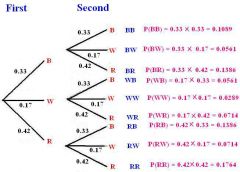![]()
![]()
![]()
Use LEFT and RIGHT arrow keys to navigate between flashcards;
Use UP and DOWN arrow keys to flip the card;
H to show hint;
A reads text to speech;
5 Cards in this Set
- Front
- Back
|
Conditional probability formula
|

|
|
|
Independent Event
|
Event whose occurrence or non-occurrence is not in any way influenced by the occurrence or non-occurrence of another event. Statistically, the probability that both events will occur is equal to the product of their separateprobabilities.
|
|
|
Tree Diagram
|

|
|
|
General Multiplication Rule
|
Using the specific multiplication rule formula is very straightforward. Just multiply the probability of the first event by the second. For example, if the probability of event A is 2/9 and the probability of event B is 3/9 then the probability of both events happening at the same time is (2/9)*(3/9) = 6/81 = 2/27.
|
|
|
Conditional Probability
|
Conditional probability can be thought of as looking at the probability of one event occurring with some relationship to one or more other events. For example:
Event A is that it is raining outside, and it has a 0.3 (30%) chance of raining today.Event B is that you will need to go outside, and that has a probability of 0.5 (50%). A conditional probability would look at these two events in relationship with one another, such as the probability that it is both raining and you will need to go outside. The probability of A and B occurring with each other becomes 0.3 * 0.5 = 0.15. |

